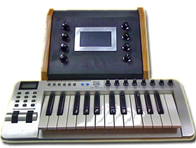Overview
The synthesia platform is a project whose purpose isto create an Analogue modelling musical synthesizer; that is, a synthesizer implemented using both analogue and digital components that intends to emulate the sounds of traditional analogue synthesizers, whilst being controllable through modern-day digital protocols such as the Musical Instrument Digital Interface (MIDI).
The synthesizer platform exists upon it’s own standalone hardware, and may be controlled using a variety of existing MIDI-capable instruments, including keyboards, guitars and drums.
Additionally, the unit features it’s own innovative touch-screen interface which intends to
provide simple-and-intuitive control of the system, but with an unprecedented ability to
customize and control synthesizer parameters and sound generation.
Special attention has been placed upon the usability of the synthesizer, particularly within the realms of it being played by musicians in a live environment.
The unit’s MIDI capabilities also mean that it is easily combined with professional studio
equipment and sequencing software such as Cubase VST
Features at a glance
its final form the project implemented the following features:
MIDI input from a variety of instruments
Unlike traditional analogue synthesizers, whose input was limited to a keyboard,ribbon controller, or patching area, the HMS-1 is compliant with general MIDI
specifications. This means that any MIDI-enabled device can be used to operate the
device, including guitars, sequencers, flutes and keyboards.
Fully assignable controlsz
The HMS-1 has the ability to have nearly all controls (excluding envelope drawing)automated over MIDI. This enables the parameters to be altered using tactile MIDI
control surfaces or even sequenced and time-automated using MIDI scoring software.
Tactile control using built-in surface
For increased usability in a live environment, the synthesizer features it’s own 8-knob
tactile control surface. The knobs included are highly sensitive and are fully assignable
to synth parameters.

Intuitive touch screen user interface
The synthesizer was developed with the needs of musicians in mind, and an elegant
graphical user interface was developed that is powerful, yet easy to use was
implemented and is easily navigated and controlled by a musician’s finger.

Vocoder/ Ring modulator
The HMS-1 features a line input who’s signal can be modulated and filtered with thatof the internal oscillators, allowing it to be connected to an external hardware such as
a function generator or microphone for ring-modulation or vocoder-type effects.
Selectable note-priority scheme
Due to it’s monophonic nature, the synthesizer features the ability to select whichpriority scheme is used to set it’s resulting output note frequency.
Monophonic Arpeggiator
A monophonic arpeggiator based loosely on that found in the Roland Jupiter 4 has
been included as part of the synthesizer’s firmware. This supports the following arp
patterns:
o Up
o Down
o Up+Down
o Random

3 independent oscillators with customisable offsets and waveforms
The HMS-1 features 3 independent oscillators; the frequency of each can be offset by+- 1 octave from the input note. These oscillators have settable frequency between 1
and 25088Hz and can be set to the following periodic waveforms:
o Sine
o Square
o Triangle
o Sawtooth
Low Frequency Oscillator (LFO)
An LFO has been included with the system to control the vibrato of output sound. It’soutput frequency can be set between 0-20Hz and is modulated with the output of the other oscillators
Selection of oscillator mixing styles
The synthesizer features the ability to select between additive and multiplicative mixing
techniques for it’s oscillator outputs. Subtractive mixing may be considered in future
revisions of the project
Software driven legato and portamento control
The HMS-1’s onboard support for legato and portamento allows for note-holding and
smooth note transtions at an adjustable rate
Adjustable, digitally controlled analogue filter and resonator
At the heart of it’s analogue post-processing functionality, the synthesizer features a
digitally controlled CEM3389 analogue signal processor. This provides the synthesizer
with a wide-range, rich sounding Voltage Controlled Filter (VCF) with adjustable
resonance and cutoff frequency parameters.
Novel touch-gesture based envelope generator
The synthesizer’s note amplitude envelope can be “drawn in” with the user’s finger,
creating a highly original experience in synth control

Ability to save and load preset patches
MIDI mappings and parameter settings may be loaded and saved to file and sharedamongst users in the synth community using the synthesizer’s preset functionality. The
interface features an onscreen keyboard for the naming of preset patches, and the
device has enough user-dedicated memory to support a near-infinite amount of

